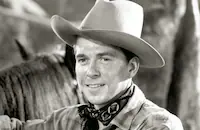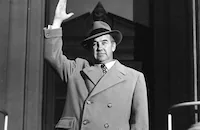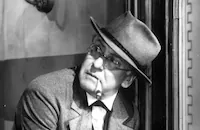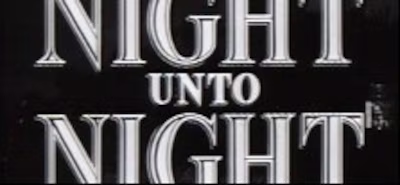Night unto Night

Brief Synopsis
Cast & Crew
Don Siegel
Ronald Reagan
Viveca Lindfors
Broderick Crawford
Rosemary Decamp
Osa Massen
Film Details
Technical Specs

Synopsis
While looking for a place to rent on Florida's east coast, scientist John Gaylord meets widow Ann Gracie outside her rambling house. Because she seems deeply disturbed by something, John offers to drive her into town. He drops her at the home of her friends, artist C. L. Shawn and his wife Thalia. They invite John inside, and there, Ann reveals that while packing the possessions of her dead husband Bill, she heard his voice. John is skeptical, but Shawn professes his belief in life after death. Later that evening, John suffers an epileptic attack at his hotel, and the following day, he visits a doctor, who explains that John's condition is deteriorating. After John rents Ann's house, her flirtatious sister Lisa pays him a visit. John questions Lisa about Ann, and learns that Bill was killed during the war. Rather than leave town, as Lisa advises, Ann takes a job managing an auto court near her house. One day, John encounters her walking along the beach, and again, Ann insists that she heard Bill's voice that day in the house. Later, John drops in on Shawn, who questions his beliefs about death. John has kept his epilepsy a secret from his new friends, but at an exhibition of Shawn's work, Shawn accidentally discovers the truth. Lisa continues to visit John, but when she kisses him, he rebuffs her advances. One day, while John spends the day with Shawn and his family, Ann is drawn to the house and again hears Bill's voice advising her not to live in her memory. She is still sitting in the house when John returns, and he comforts her. Soon, Ann and John fall in love. One night, John has another, much stronger, seizure. He considers suicide, but is interrupted by the arrival of Dr. Poole, who had treated him in Chicago. Poole explains that John telephoned him during the night while still suffering from the effects of his seizure. Learning of John's love for Ann, Poole advises him to tell her the truth about his condition, but John decides to break off their relationship. The following day, Poole and Shawn have a philosophical discussion, and during its course, Poole reveals that John is getting sicker. When Shawn later realizes that Ann has fallen deeply in love with John, he is disturbed and tells her about John's illness. John holds a dinner party in Poole's honor, and as a hurricane approaches, a drunken Lisa jealously starts to verbally attack Ann. After the storm knocks out the lights, John and Ann search for lamps, and she reveals that she knows about his condition, but does not care. Lisa overhears and taunts John, who leaves the room. Ann follows, and finding him with a gun, begs him not to kill himself. Passionately, she describes the eternal nature of love and proclaims her belief that all happiness should be embraced, even if it only lasts for a short time. Persuaded to accept Ann's love, John decides not to commit suicide.

Director

Don Siegel
Cast

Ronald Reagan

Viveca Lindfors

Broderick Crawford

Rosemary Decamp

Osa Massen
Art Baker

Craig Stevens

Erskine Sanford
Ann Burr
Johnny Mcgovern
Lillian Yarbo
Ross Ford
Almira Sessions
Dick Elliott

Irving Bacon
Lois Austin

Jack Mower
Larry Rio
Ramon Ros
Leo White

Paul Panzer
Jack Wise
Billy Bletcher
Philo Mccullough
Creighton Hale
Bing Conley
Joe Devlin
William Haade
Dick Johnstone
Dennis Donnelly
Crew
Harry Barndollar
Lou Baum
G. W. Berntsen
Owen Crump
Jack Daniels
Edwin Dupar
Leo F. Forbstein
Oliver S. Garretson
Oren Haglund
James Leicester
Peverell Marley
Leonid Raab
Thomas Reilly
Hugh Reticker
Leah Rhodes
Kathryn Scola
Jack L. Warner
Franz Waxman
Perc Westmore

Film Details
Technical Specs

Articles
Night Unto Night
Biochemist John Galen (Reagan) has fled Chicago for a place where he can be alone and wrestle with a mysterious illness that pulls him into unexpected trances and cues the ominous organ music that signifies mental torment. He finds the ideal retreat in a huge Victorian mansion owned by Ann Gracy (Lindfors), who is afraid to enter the house, because she hears the voice of her late husband whenever she ventures inside. A natural skeptic ("After all," he says, "I am a scientist"), Galen tries to explain away the mysterious voice as auto-hypnosis, but it is clear he and she are very much alike: "psychological shut-ins," one character calls them, who have chosen to hide from rather than face the realities of their situations.
Frustrated artist C.L. Shawn (Broderick Crawford) serves as the mouthpiece of the expanded consciousness, taking every opportunity to launch into passionate soliloquies on man's quest for spiritual enlightenment, prodding the two protagonists to tackle their torments head on. Ann's shallow sister Lisa (Osa Massen) tries to seduce Galen, without success. Inevitably the romantic attraction occurs between Ann and Galen, and the cool-headed scientist eases Ann out of earshot of the voices in her head. But Galen's ailment is not so easily eluded. It is revealed that he suffers from epilepsy, which appears to be intensifying. Lisa taunts Ann, "What a chance for little Ann to be noble. Now she can really wear the halo. You're welcome to him, dearling. You can have the pleasure of watching him twist and writhe." As a hurricane lashes the coast, one question must be resolved: will Ann allow Galen to crawl off alone and die, or will she stand by him, and possibly be haunted by a second voice in the gothic seaside mansion?
Much of the film's eerie flavor is due to the cinematography of J. Peverell Marley (House of Wax [1953]) and Franz Waxman's haunting score, which often echoes melodies from his music for The Bride of Frankenstein (1935).
The ornate waterfront mansion was built in miniature, and is featured in several amazing special effects shots. At the beginning of the film, the camera opens in an extreme wide shot, then floats through the woods, up to the house, through its screen door, and into the foyer (accomplished by a dizzying combination of matte photography, miniatures and subtle optical effects). Unfortunately the virtuoso tracking shot, achieved by Harry Barndollar and Edwin DuPar, is hidden behind the opening credits. Another dramatic tracking shot occurs at night during the hurricane at the end of the film, but is likewise obscured by the closing credits.
A dark and convoluted film, Night Unto Night was filmed under a variety of ominous clouds. For starters, the film's director was unenthusiastic about the project. "The script, written by Kathryn Scola, was given to me by the producer, Owen Crump. I read it immediately," wrote Siegel in his autobiography, "Unfortunately, I didn't like it or understand it. [He particularly didn't care for Crawford's scripted soliloquies which he referred to as "endless, boring, philosophic, incomprehensible advice."] Certainly it wasn't a project for me. But I had no choice, no court to appeal to. I was bound to a long-term contract, which spelled out in no uncertain terms that I directed what was given to me, or [faced] immediate suspension."
Another command Siegel was required to obey was to direct the film during a major labor strike ("the Screen Directors Guild and my agent and my lawyer insisted I had to report to work," Siegel said). The strike was the second cloud hanging over the production. According to Anne Edwards' biography Early Reagan: The Rise to Power, "All the actors and the crew had to pass through an extremely hostile picket line to make their way into the studio. Jack Warner had obtained big buses driven by members of the Teamsters Union, whose rank and file had voted unanimously not to cross the picket line. Four days into the production, violence erupted, cars were overturned and set on fire, people were screaming, many were injured."
"When we left on the large bus, passing the jeering strikers, I insisted on sitting next to the window, Viveca sitting beside me," Siegel recalled, "She thought it was very gallant of me to shield her from possible shattered glass if the strikers started throwing things at the bus. I liked the idea of Viveca thinking me gallant, but I felt like a damn fool because...I didn't know what the strike was about."
The strike had begun on March 12, 1945, organized by the Conference of Studio Unions in response to the studios' delay in granting contract renewals for its interior decorators. But the significance of the strike spread well beyond set-dressers. The CSU saw itself as a truly democratic labor union, bound by philosophic ideals bordering on socialism, and wanted to distance itself from the often violent, power-hungry unions that controlled most of the industry. The IATSE (International Alliance of Theatrical Stage Employees) felt the CSU was attempting to "raid" its members and steal away the interior decorators.
Father George H. Dunne, who was active in the Hollywood labor struggle, characterized the IATSE as "gangsters," and believed that the studios and the IATSE worked together to crush the CSU strike. "There's not room in Hollywood for the IATSE and the CSU," IATSE head Roy Brewer allegedly told Dunne, "It's a war to the finish."
Leading man Reagan was a key figure in resolving the strike. He was appointed to an Emergency Committee formed by the Screen Actors Guild to help settle the strike and avoid a work stoppage. Reagan advocated crossing the picket line and demonized the CSU. Dunne later concluded, "He was doing a job for the producers...he played a key role in cooperation with... the thoroughly immoral Chicago gangster outfit [the IATSE] to destroy what was the only honest and democratic trade-union movement in Hollywood [the CSU]. They [IATSE and the producers] did this to them, and Reagan played a key role in that destruction" (quoted in Early Reagan). Shortly thereafter, Reagan's leadership was rewarded. He was elected President of the Screen Actors Guild.
In his autobiographical book Where's the Rest of Me?, Reagan calls Night Unto Night "an unusual story, as most of [Wylie's] are, and I'm not sure we got the most out of his book." One of the most problematic scenes was one in which Galen helps Ann confront the memory of her husband's death, triggered by the sight of two people riding horseback on the beach. "We photographed this scene four times, and rejected it each time when it was shown in the rushes: it just didn't come off." Reagan then made his "first foray into script doctoring." He proposed a flashback in which "the horseback riders [ask] her for directions to a phone to call the Coast Guard; they had come upon bodies and wreckage on the beach. Going back with them, she had discovered her husband," explained Reagan. "Her traumatic condition was explained in the line (somewhat poetic), 'It was almost as if in death he had tried to come back to me.' Frankly, I was kind of proud of it. After all, it was a basis for believing in ghosts when you stop to think he could have drifted in on any part of four thousand miles of coastline." The scene was rejected, and producer Crump is reported to have said, "My God, don't ever let an actor get a pencil in his hand!"
Night Unto Night was shot between September 19, 1946 and January 18, 1947 (with additional retakes in the Spring). It was intended as a vehicle for Swedish import Lindfors, who was being groomed as another Ingrid Bergman (whose Notorious was released in 1946). It was the first American film Lindfors worked on, though it would not be her U.S. debut.
Dissatisfied with the film, Warner Bros. held up Night Unto Night's release for two years. By that time, Lindfors had appeared in To the Victor (1948) and Adventures of Don Juan (1948), both produced by Warner Bros.
When Night Unto Night finally did come out, Lindfors had left Warner Bros., divorced her husband and married director Siegel, with whom she had fallen in love during filming ("I had not had sex with a man for several months," Lindfors later recalled, "I was hot and hungry"). But their marriage was destined to be as ill-fated as the film; Lindfors and Siegel divorced in 1953.
"It fails to come off entirely but has the elements of appeal to the femme ticket-buyer because of an embroidery of romantic drama," wrote Variety. "This angle can be exploited and some business will result, but the box-office going will be spotty." The critic's predictions were spot-on.
Night Unto Night earned a mere $449,000 at the U.S. box-office, against a total cost of $1.8 million, making it a bitter disappointment to all concerned. The critical response was no better. The Hollywood Reporter called it, "interesting at times, but never good entertainment...Reagan never seems quite at home in his difficult role, although he makes a valiant effort to make it convincing," while Time remarked, "Nothing much happens...Reagan plays the role with the abstracted air of a man who has just forgotten an important telephone number."
In its June 11, 1949 review, The New York Times quipped that, "Having waited so long to expose Night Unto Night to the light of day, the Warners might better have left it at the bottom of the well, for some things are best forgotten."
Reagan and Siegel were reunited again for the hardboiled drama The Killers (1964). It would be Reagan's last film before embarking on a career in politics.
Producer: Owen Crump, Jack L. Warner
Director: Don Siegel
Screenplay: Kathryn Scola, Philip Wylie (novel)
Cinematography: J. Peverell Marley
Film Editing: Thomas Reilly
Art Direction: Hugh Reticker
Music: Franz Waxman
Cast: Ronald Reagan (John Galen), Viveca Lindfors (Ann Gracy), Broderick Crawford (C.L. Shawn), Rosemary DeCamp (Thalia Shawn), Osa Massen (Lisa), Art Baker (Dr. Poole).
BW-84m.
by Bret Wood

Night Unto Night
Quotes
Trivia
Notes
The title of Philip Wylie's novel was taken from the Nineteenth Psalm, "Day unto day uttereth speech, and night unto night skeweth knowledge." After the novel was purchased by Warner Bros., a January 21, 1946 Daily Variety news item speculated that Bette Davis would play the part of "Ann." The film was originally intended to be Viveca Lindfors' American debut, but its release was delayed, and by the time the film was finally released, Lindfors was no longer under contract to Warner Bros. Lindfors and director Don Siegel married in 1949. Night Unto Night was the only film on which they both worked.

Miscellaneous Notes
Released in United States 1949
Released in United States 1949














